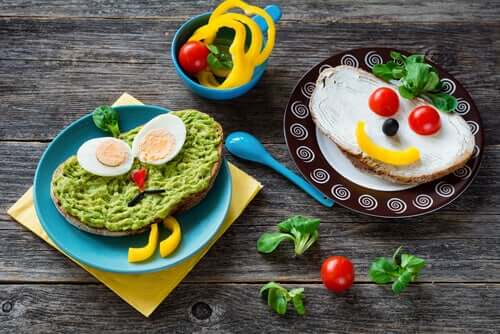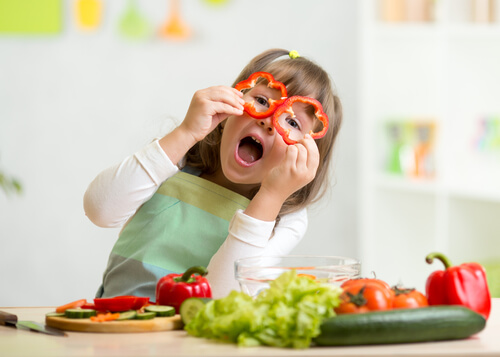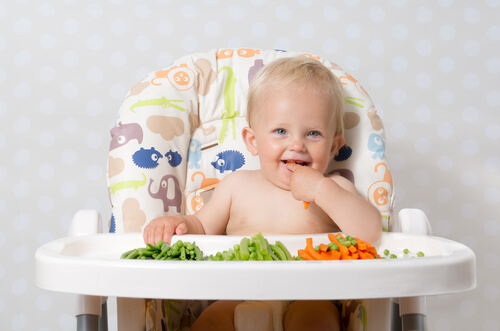Getting Kids to Eat More Vegetables

Many children hate vegetables and children who dislike them are likely to eat more junk food. So, here we’ll offer some advice on getting kids to eat more vegetables.
The importance of eating vegetables
Vegetables are an essential source of vitamins (like A, C, and B9), minerals (like magnesium, potassium, calcium, sodium, and iron), fiber and antioxidants. All of these are essential to everybody’s diet.
Eating vegetables, fruits and legumes ensures proper nutrition for children and also determines the healthy habits they’ll have for life. This is key to helping them prevent diseases and avoiding nutritional deficiencies, like atherosclerosis, irritable bowel syndrome, anemia, cancer, osteoporosis, etc.

Getting kids to eat more vegetables
Feed them vegetables early on
Try to introduce your children to a lot of different flavors when they’re young. The sooner the better. Between 5 to 6 months of age, babies can start eating vegetables like carrots, green beans, and potatoes. You can either boil them or mash them.
At 8 months old, let them try tomatoes (boiled, without seeds nor skin). After they turn 1 year old, try preparing them whole and boiled. Between 12-18 months of age, you can start giving them raw salads, but avoid cabbage or artichokes because these can cause gas.
Keep trying
It’s fine if children refuse to eat them, just keep trying. Do it little by little. Don’t force things, don’t challenge or punish them if they don’t want to try it. This will only create a psychological rejection and will lead them to associate vegetables with something bad.
Make it fun
A 2012 study found that children like food with a lot of ingredients and colors, especially when they form a certain shape. Try making a mash of different colors (carrots for orange, beets for purple), or make animal faces or a forest made out of broccoli.

If they still don’t like vegetables, give them other options
If your children don’t like what you give them, let them choose among vegetables or legumes. This way, they’ll participate and it’ll be more fun to try new things. Besides, this way you can understand what your child likes.
Another tip is to take your children grocery shopping with you and let them choose whatever vegetables they like best.
Children can cook, or at least they’ll try it
Let them get involved in the cooking process. They can make simple dishes like salads. Or let them heat the plate in the microwave.
Everyone in the family needs to eat more vegetables too
Children copy what they see. That’s why it’s important that the whole family eats them too. Keep fruits, vegetables, and legumes where the children can see them. When they see that everybody’s eating it, they’ll feel important and like grown-ups.

Mixing everything up
Most of the time, children like dishes like Mac & Cheese, scrambled eggs, pizzas, etc. These are great to throw some veggies to the mix. Another way could be mixing food with healthy sauces. Some dishes will be more successful than others, like Cauliflower Cheese, than just boiled broccoli. You could also cook vegetables tempura style, and eat them like fries.
Yes, children don’t always like eating their greens, but you can make their meals fun and they’ll start to eat more vegetables in no time!
Many children hate vegetables and children who dislike them are likely to eat more junk food. So, here we’ll offer some advice on getting kids to eat more vegetables.
The importance of eating vegetables
Vegetables are an essential source of vitamins (like A, C, and B9), minerals (like magnesium, potassium, calcium, sodium, and iron), fiber and antioxidants. All of these are essential to everybody’s diet.
Eating vegetables, fruits and legumes ensures proper nutrition for children and also determines the healthy habits they’ll have for life. This is key to helping them prevent diseases and avoiding nutritional deficiencies, like atherosclerosis, irritable bowel syndrome, anemia, cancer, osteoporosis, etc.

Getting kids to eat more vegetables
Feed them vegetables early on
Try to introduce your children to a lot of different flavors when they’re young. The sooner the better. Between 5 to 6 months of age, babies can start eating vegetables like carrots, green beans, and potatoes. You can either boil them or mash them.
At 8 months old, let them try tomatoes (boiled, without seeds nor skin). After they turn 1 year old, try preparing them whole and boiled. Between 12-18 months of age, you can start giving them raw salads, but avoid cabbage or artichokes because these can cause gas.
Keep trying
It’s fine if children refuse to eat them, just keep trying. Do it little by little. Don’t force things, don’t challenge or punish them if they don’t want to try it. This will only create a psychological rejection and will lead them to associate vegetables with something bad.
Make it fun
A 2012 study found that children like food with a lot of ingredients and colors, especially when they form a certain shape. Try making a mash of different colors (carrots for orange, beets for purple), or make animal faces or a forest made out of broccoli.

If they still don’t like vegetables, give them other options
If your children don’t like what you give them, let them choose among vegetables or legumes. This way, they’ll participate and it’ll be more fun to try new things. Besides, this way you can understand what your child likes.
Another tip is to take your children grocery shopping with you and let them choose whatever vegetables they like best.
Children can cook, or at least they’ll try it
Let them get involved in the cooking process. They can make simple dishes like salads. Or let them heat the plate in the microwave.
Everyone in the family needs to eat more vegetables too
Children copy what they see. That’s why it’s important that the whole family eats them too. Keep fruits, vegetables, and legumes where the children can see them. When they see that everybody’s eating it, they’ll feel important and like grown-ups.

Mixing everything up
Most of the time, children like dishes like Mac & Cheese, scrambled eggs, pizzas, etc. These are great to throw some veggies to the mix. Another way could be mixing food with healthy sauces. Some dishes will be more successful than others, like Cauliflower Cheese, than just boiled broccoli. You could also cook vegetables tempura style, and eat them like fries.
Yes, children don’t always like eating their greens, but you can make their meals fun and they’ll start to eat more vegetables in no time!
All cited sources were thoroughly reviewed by our team to ensure their quality, reliability, currency, and validity. The bibliography of this article was considered reliable and of academic or scientific accuracy.
- Fundación Española de Nutrición. (2018). Informe de estado de situación sobre “Frutas y Hortalizas: Nutrición y salud en la España del S.XXI”.
- Villaresa, JM Moreno, and MJ Galiano Segoviab. (2006). “El desarrollo de los hábitos alimentarios en el lactante y el niño pequeño. Sentido y sensibilidad.” Revista Pediatría de Atención Primaria 8.Suplemento 1.
- Zampollo F, Kniffin KM, Wansink B, Shimizu M. (2012). Food plating preferences of children: The importance of presentation on desire for diversity. Acta Paediatr. Wiley Online Library; 2012;101(1):61–6.
This text is provided for informational purposes only and does not replace consultation with a professional. If in doubt, consult your specialist.








